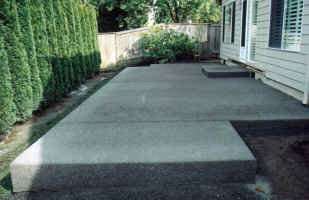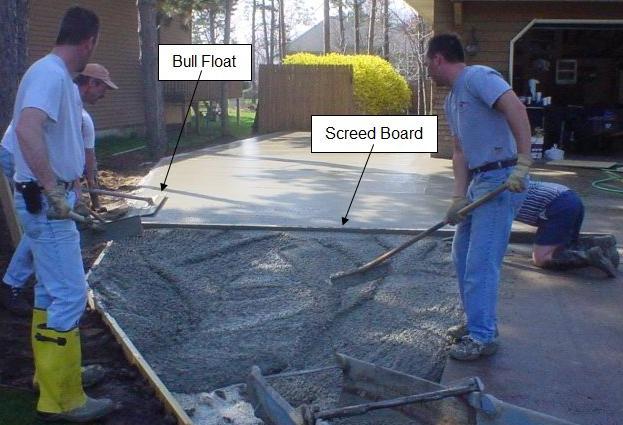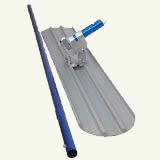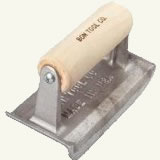
Figure 1 - Concrete slab
Many handymen find the finishing of a concrete pour to create a smooth and level surface to be a very difficult task.
There are three tasks involved in finishing a concrete slab and creating a level and smooth finish:
- Striking-off
- Floating
- Edging
- Striking-off:
Striking-off is the process of leveling the concrete with the aid of a screed board. A screed board, in its simplest form, is a straight and smooth 2 x 4.
If you are pouring a large slab or multiple slabs you may want to consider buying or renting an aluminum screed board, as shown in Figure 2. The aluminum screed board is perfectly straight and has sharp edges, which makes the tool easier to use. Aluminum screed boards come in variety of lengths, from 6″ to 14″.

Figure 2 - Aluminum screed board
The best way to use the screed board is to have both ends resting on the form. Then using a sawing action move the screed board back and forth while moving forward, as shown in Figure 2b.

Figure 2b - Striking-off and floating a concrete slab
For the non-professional, home handyman, making multiple passes with the screed board, moving small amounts of concrete, provides a superior finish then trying to move and level a lot of concrete in one pass.
A proper strike-off of the concrete slab will provide a level, flat surface with only minor imperfections. These imperfections are removed by floating
the concrete slab.
- Floating:

Figure 3 - Bull float

Figure 4 - Hand float

Figure 5 - Concrete edger
Floating the surface of the concrete, as shown in Figure 2, after performing the strike-off, settles the larger pieces of aggregate below the surface which will create a smoother more durable surface layer of concrete.
The majority of the floating process is accomplished with the use of a bull float
as shown in Figure 3. Bull floats are made of aluminum or magnesium and come in a variety of sizes and shapes.
To use the bull float over the concrete, maintain a low angle. A high angle will push the concrete in front of the float.
Use the bull float to finish the concrete within a foot of the forms. Then finish the floating with the use of a hand float, as shown in Figure 4.
Using a fast back and forth action with either the bull float or hand float will cause the water in the concrete to rise to the surface, which in turn will level have a self leveling effect on the concrete allowing it to fill any low areas.
- Edging:
The edges of a concrete slab commonly chip and break-off if they are left at sharp 90 degree angles. To help prevent the edges of the concrete slab from chipping or breaking off use a concrete edger to round-off the edges. The concrete edger, as shown in Figure 5, is a simple to use tool and should be used on all outside concrete slab edges.
